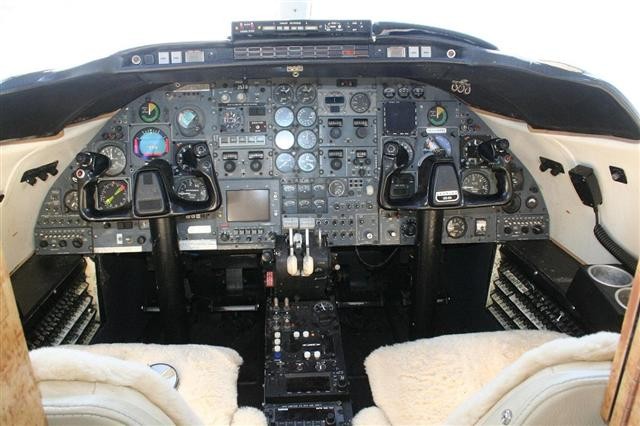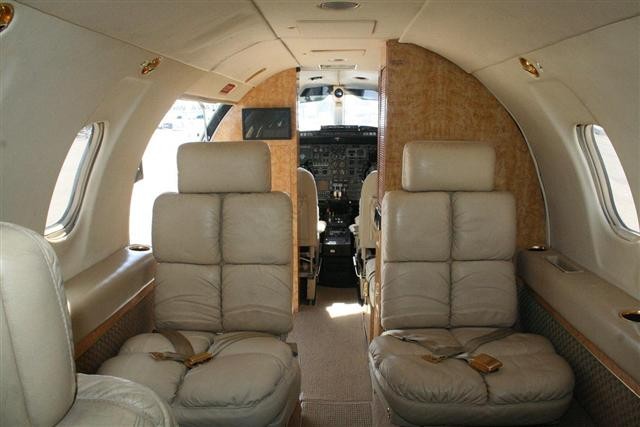


Aircraft Description
Background/History
Bill Lear’s original Learjet 23 first flew in October 1963. The Learjet 24, introduced in 1966, certified under FAR part 25 boasted higher operating weights, including an increase in MTOW from 12,500lbs. to 13,500lbs. Plans were already underway to upgrade the powerplants to newer and slightly more powerful versions of the CJ610, and fuel capacity would be increased to give the aircraft considerably greater range. An area that remained to be addressed however, was the limited seating capacity and small cabin. The model 25 was the first stretched Learjet, employing a 4.2ft. fuselage plug. The Lear 25 was developed roughly concurrently with the Learjet 24, and made its first flight in August 1966, just six months after the first flight of the 24, and was certified in 1967. The Learjet 25B and 25C models were introduced in 1970 and 1971 respectively, with increased fuel capacity and corresponding increase in range. The 25D debuted in 1976 and introduced aerodynamic refinements including a recontoured leading edge, which improved cruise performance and low-speed handling. The Learjet 25D was produced through 1985 with a production run of 164 aircraft.
Power
The Learjet 25 was originally powered by a pair of General Electric CJ610-4 turbojets engines rated at 2,850lbs of thrust each. Later variants included the 25D and 25G, powered by the CJ610-8A engine rated at 2,950lbs. of thrust each. Inspection interval on the -8A engines is 5,000 hours.
Avionics
A wide range of equipment combinations will be found in Learjet 25’s, but a typical example might include dual Collins VHF 20 comms, dual VIR 30 navs, Collins FD108 flight director, FC110 autopilot and Bendix RDS 81 color weather radar.
Design Features
The Learjet 25 is a short to medium-range, twin-engine turbojet-powered, light business jet configured as a cantilever low-wing monoplane with a T-tail. It has straight wings with only a slight leading-edge taper, a low aspect-ratio and rather large tiptanks. The twin turbojet engines are pylon-mounted on either side of the aft fuselage. The retractable tricycle landing gear has a fairly narrow track of 8.3ft. and mounts dual wheels on each main unit with a single nose wheel. The 25D introduced a revised leading edge contour and a stick shaker coupled to a computerized angle-of-attack system for better low speed characteristics and reduced runway length requirements. Ice protection is provided by engine bleed air, for both wings and windshield, with methyl alcohol as a windshield backup. Tail surface leading edges and pitot-static are electrically heated.
Accomodations
The Learjet 25D is normally configured for six passengers in a seating arrangement consisting of four individual forward facing seats, and a full-width bench seat aft of these. A baggage compartment of approximately 40cu.ft is located aft of the fold-down bench seat, and is accessable only from inside the cabin. The half-width lavatory is located along the forward starboard side of the cabin, across from the airstair door. Cabin dimensions are 4.3ft. in height, 4.9ft. in width and 12.1ft. in length.
| General | Learjet 25D, LR-25D | |||
|---|---|---|---|---|
| Category | Jet < 20,000 lbs. | |||
| Years Aircraft Manufactured | 1976 – 1985 | |||
| Serial Number Range | 206 – 373 various | |||
| Retail High Price | $750,000.00 / 588,525.00€ | |||
| Retail Low Price | $159,000.00 / 124,767.30€ | |||
| Characteristics | Learjet 25D, LR-25D | |||
| Seating | 2 + 7/10 | |||
| Wing Loading | 64.7 | |||
| Power Loading | 2.5 | |||
| Noise(EPNdB): Takeoff/Sideline/Approach | 90.1/95.2 | |||
| External Dimensions (ft) | Learjet 25D, LR-25D | |||
| External Length | 47.6 | |||
| External Height | 12.3 | |||
| External Span | 35.6 | |||
| Internal Dimensions (ft) | Learjet 25D, LR-25D | |||
| Internal Length (Overall/Net Height) | 12.1 | |||
| Internal Height | 4.3 | |||
| Internal Width (Max/Floor) | 4.9 | |||
| Baggage | Learjet 25D, LR-25D | |||
| External: Cu.Ft./Lb. | N/A | |||
| External: Cu.Ft./Lb. | N/A | |||
| Power | Learjet 25D, LR-25D | |||
| Engines | 2 GE CJ610-8A | |||
| Output (lbs ea.)/Flat Rating | 2,950 | |||
| Inspection Interval | 5,000t | |||
| Data based on latest manufactured year | ||||



